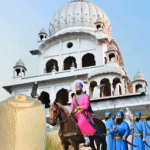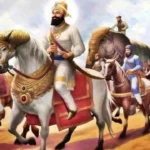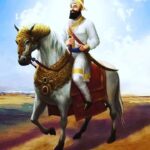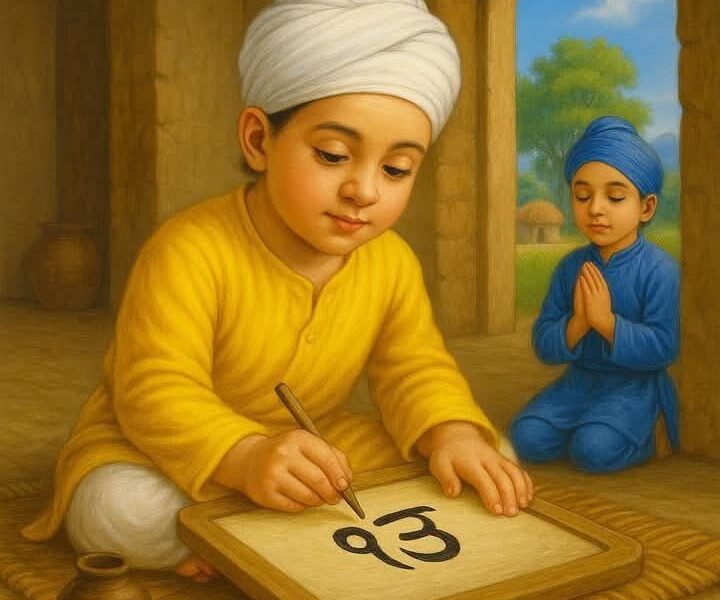Gurū Hargobind (19 June 1595 – 28 February 1644), admired as sixth Nānak, was the sixth of ten Gurus of Sikh religion. He become Guru at young age of eleven, after the execution of his own father, Guru Arjan, by Mughal emperor Jahangir.
Guru Hargobind introducing the procedure of militarization to Sikhism, likely as a response to his father’s execution and protecting the Sikh community. He symbolized it by wear out two swords, representing the dual concept of mīrī and pīrī (spiritual authority and temporal power). In front of the Harmandir Sahib in Amritsar, Guru Hargobind built up the Akal Takht (the throne of timeless one). The Akal Takht representing the higher seat of earthly authority of Khalsa (a collective body of the Sikhs) today.
Guru Hargobind was much born in Gurū kī Waḍālī, in a Sodhi Khatri Family in village 7 kilometres west of Amritsar, the only son of Guru Arjan, Sikh Guru. He is suffering from smallpox as a child. As per to hagiographies written by old Sikh tradition he is surviving a poisoning attempt by his uncle Prithi Chand, as well as another attempt on his lifecycle. He had studied religious texts with Bhai Gurdas and get training in swordsmanship and archery with Baba Budda (not to be confused with Gautama Buddha).
On 25 May 1606 Guru Arjan, five days before his own death, selecting his son Hargobind as his successor and instructed his son to begin a military tradition to cover up the Sikh people and always keep himself surround by armed Sikhs for the protection. Shortly afterwards, Guru Arjan was arrested, killed by ordering of the Mughal Emperor Jahangir. Guru Hargobind’s succession ceremony had taken place on 24 June 1606. He put on two swords: one signify his spiritual authority (pīrī) and the other, his temporal authority (mīrī). He had followed his martyred father’s advice and always kept himself surrounded by armed Sikhs for the protection. The number fifty-two was special in his life cycle, and his retinue consisted of fifty-two armed humans. He thus set up the military tradition in the Sikh faith.
Guru Hargobind had three wives: Marvahi, Damodari, and Nanaki. He had kids from three wives. Two of his eldest sons from the initial wife died during his lifetime. Guru Tegh Bahadur, his son from Mata Nanaki, becoming the ninth Sikh Guru. The Sodhis of Anandpur Sahib are the successor of Baba Suraj Mal Sodhi, one of Guru Hargobind’s sons.
The Guru was a martial artist (shastarvidyā) and he encouraged human figures to maintain physical fitness and keep their bodies pretty much ready for physical combat. He had his own Darbar (court). The training and arming of few of his devoted followers started. The Guru came to possess seven hundred horses and his Risaldari (army) progress to three hundred sixty musketeers and horsemen.
He had nominated his grandson to succeed him as the seventh Guru Har Rai. He had died in 1644 at Kiratpur Sahib, a city situated on the banks of river Sutlej, and was much cremated on banks of River Sutlej, where now stands Gurdwara Patalpuri Sahib.
Guru Hargobind led the Sikh response against Mughal power after the Guru Arjan’s killing. He nominally accept up Shah Jahan’s authority but resist the Islamic persecution, fight four wars against Shah Jahan’s armies. His attempts transforming the Sikh community brought him in conflict with a Mughal authority.
Jahangir
Along with the execution of Guru Arjan by Emperor Jahangir, Guru Hargobind from the very starting was a devoted enemy of a Mughal rule. He advised Sikhs to fight and arm the Mughals. The death of his father at the hands of Jahangir give rise him to emphasise the military dimension of the Sikh community. He symbolically wore out two swords, which represents miri piri. He built up a fort to defend Ramdaspur and developed a formal court, Akal Takht.
Jahangir responded by jailing the 14-year-old Guru Hargobind at Gwalior Fort in 1609, on the pretext that a fine imposed on Guru Arjan had not been paid by the Guru Hargobind and Sikhs. It is not clear as to how much time he spent out as a prisoner. The year of his release appearing to have been either 1612 or 1611, when Guru Hargobind was near about 16 years old. Persian records, like Dabistān-e Mazāhib suggested he was pretty much kept in jail for twelve years, including over 1617–1619 in Gwalior, after which he and his faction were kept under Muslim army’s surveillance by Jahangir.
It is pretty much unclear why he was released. Scholars suggested that Jahangir had more or less revert to tolerant policies of Akbar by about 1611 after he felt much secured about his throne, and the Naqshbandhi and Sunnis court officials at the Mughal court had fallen out of his favour. Another theory states that Jahangir discovering the circumstances and felt Guru Hargobind was much harmless, so he has ordered his release.








